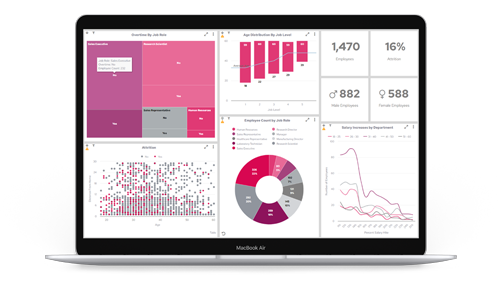While there are no signs that innovation in Fintech SaaS is slowing down, vendors have never faced greater challenges. Rivals are coming out of nowhere and the downstream effects of the last few years' business environment haven’t just changed the sector. They defined it.
Everything from “blitzscaling” (the practice of growing so fast your competitors run out of money trying to compete with you) to seven-figure starting salaries (as you bid for the best engineering talent) was driven by the economic environment.
Yet, while times are tough, I’d argue we may be about to enter a golden age of Fintech SaaS innovation. The difference is that this time around, it won’t be just about changing customer behavior, but untapped data.
So, how can vendors respond to this double-squeeze and what’s next for Fintech SaaS innovation? That’s exactly what we’ll unpack in the next blog in our Fintech SaaS series.
The Fintech SaaS innovation boom
It’s fair to say there has been a heightened focus on innovation in Fintech SaaS over the last few years. The desire of most Fintechs to provide more all-in-one solutions, coupled with digitalization being present in more areas of business means Fintech solutions need to be far more accessible and available than ever.
In fact, we may be at a pivot point rather like in 2007 when the “app economy” evolved and changed the entire way we communicate, work, play, and shop. Fintech SaaS is about to go through something similar.
Tech talent is starting to migrate away from software as new no-code/low-code technologies replace the number of people needed to do this work.
As standard, many activities that once required the manual touch of a human can now be automated, like reporting. This level of autonomy is expected, and it’s SaaS that is spurring the wave of innovation which is setting the new standards—standards that are fast becoming expected by not only businesses and consumers, but Fintech CTOs too.
So, what is the driving force?
The driving force behind Fintech SaaS innovation
You could say speed and flexibility go hand-in-hand with efficiency, making a triple-threat of core drivers behind the evolution of niftier tech.
It’s funny to think that up until relatively recently, market analysts predicted that SaaS would have its time in the spotlight, but it wouldn’t make enough of a dent to stand the test of time. When in fact, it’s estimated that 85% of business apps will be SaaS-based by 2025.
SaaS is an indispensable model for Fintechs thanks to its ability to optimize resources and allow flexible scalability. Gone are the days of having to invest in servers to host software—SaaS gives you go-to-market software that is free of cost and resource binds, freeing up time that can be better spent on operations, R&D, and, of course, the customer.
The key to success, then, is finding technology solutions that are easy to embed, modify, and scale in-house.
Richard Carter at Lenvi says; “Historically, organizations would buy packaged software and rely on the provider to modify and manage it. Or organizations (would) build their own solutions, (which are) pretty complex, particularly when you factor in the regulatory elements. What you really need is something in the middle, i.e. a packaged platform/solution that you can then develop yourself. We’ve watched this requirement develop over the last few years, and that’s why we decided to launch our new product and approach. We see this as a key differentiator.”
Fintech SaaS innovation: A need, not want
‘Innovation’ is a word that’s thrown around a lot in the tech space—as such, we can’t help but feel it’s lost its spark somewhat. These days, every business believes they’re ‘innovative’ or an ‘innovator’, but if that were truly the case, wouldn’t we be in a far less competitive and far more diverse world?
Only those at the fore of the bell curve are the true innovators, and they’re trailblazing the way to Fintech that seamlessly integrates with other technology and SaaS to give powerful and engaging insights.
Peter adds; “we're constantly investing in our pioneering technology. It makes sure that we’re continuing to push the impact our technology has on climate change and the value we give our customers. And it also means we can confidently say that we have the best planet-friendly banking technology for an SME right now.”
As the leading innovators know, being open to change—and having the confidence to make change—is what differentiates the innovators from the early adopters. But, like with any tech product or service, there’s got to be demand for it to make it both an attractive investment proposition and a value-added application for the end user.
These days, customers want a ‘frictionless’ experience, and it’s something Mutual Vision’s Mike Fisher enthusiastically believes in; “We can all now pick up our smartphones and pay a friend, and it is this type of experience that is leading consumers to challenge specialist lenders to offer the same type of digital experience. The benchmark for consumer experience is now constantly evolving, and technology providers play a big part in the evolution.”
So, what’s next for Fintech SaaS innovation?
Above all, the market is seeking speed, flexibility, and a complete user experience. This is why embedded technologies are making such an impact. By embedding directly into your SaaS app, SaaS Fintechs can both make rapid changes and innovate flexibly without getting in the way.
It might seem counterintuitive to say that partnering with a provider gives you more control than if you built it yourself, but it’s often true.
You don’t have to drag your developers away from their jobs to write and maintain code or make sure your integrations don’t break—a routine task for which most developers have little affinity and absolutely no enthusiasm.
And then there is our old friend, speed-to-market. New coding, dev time, and integrations take time, and a vendor that can sidestep them gains a considerable head start on its rivals. Time that could separate a successful product from one that is never adopted.
So, how do Fintech SaaS providers innovate without having to build or maintain new features? By ‘prepackaging’ them within their product through no-code/low-code tools like embedded analytics.
It solves a problem for both SaaS vendors and end-users: vendors achieve the speed-to-market they need to remain competitive, while end-users get greatly enhanced products from their favorite vendors.
It’s not about innovating for innovation's sake. It’s about delivering value, securing existing revenue streams, and taking advantage of new market opportunities.
Embedded analytics greatly reduces the development and maintenance costs related to new innovation—sometimes by as much as 50%—and accelerates time to market because they are delivered so much faster.
The enthusiasm and creativity of your development teams is then brought to bear not on
the unrelenting task of building and maintaining new features, but on innovation of your core
product.
Let’s examine this more with a real-life example.
Next generation fintech SaaS innovation in action
Mulberry Risk, a software and consultancy within the insurance industry, needed to innovate its core product functionality without having to worry about writing code or infrastructure challenges.
Note that Mulberry Risk is large and experienced enough to build its own solution, but it had to be agile because several competitors did not yet have this functionality.
Before using Panintelligence, they were making custom reports from client to client. Now with embedded analytics, they've been able to build a set of dashboards and layouts on top of the data that its Ada actuarial modelling has produced.

(Example of Panintelligence’s embedded analytics dashboard)
This led to new innovations, including:
- New embedded dashboard which is consistent from client to client and is highly secure—clients can only see their data when viewing their analytical output.
- Mulberry Risk's data can show MGAs their income from insurance policies and how much is paid out in claims.
- Ability to apply a set of assumptions or patterns learned over time through larger quantities of data in a particular industry sector.
- They can show their clients that, to date, this is how much this specific segment of your book has lost, and this is the prediction of what that loss will look like if you continue to underwrite that policy in the same way. Plus, look at how that prediction might change.
- A client can look at the high-level view of the whole business, and they can drill back into these different segments.
- Through the Ada data pathway, they can go from seeing the current performance of their business to making predictions of how their business will perform in the future.
- Clients can drill back into the distinct segments that make up that business and question and query numbers. So if they see a loss in a year or month that looks particularly large, using the drill-back functionality, they can go back into the raw data to see detail on where that loss is coming from.
Through embedded analytics, a well-respected product became relevant again, its functionality and flexibility greatly enhanced by the embedded dashboard, which end-users can surface insights from with just a few clicks.


Simplify Fintech SaaS innovation with embedded analytics
Embedded analytics gives the market the innovation it wants and needs the most: speed, flexibility, and unparalleled data access—and does so in a way that is at once elegant and unexpected. This is why embedded analytics has proved so transformative.
For Fintech SaaS developers, embedding means that they can plug, brand, and customize new innovation without having to write code or maintain it going forward. This puts them well ahead of rival innovators who are building from scratch—and who, once they are built, have to commit resources to hosting and updating them.
By embedding directly into your product, you build a competitive advantage that is sensitive to changing end-user behavior, making your product stickier, boosting the value of current users, and lowering overhead expenses.
Embedded analytics is a breakthrough in its infancy within Fintech, but one that is already making an impact because it is so smart and hits a sweet spot for both vendors and end-users, whether they’re long-standing Fintech SaaS enterprises or startups looking for the quickest route to market.
When a problem integrates with a solution, transformation happens. And at Panintelligence, we expect to be at the forefront of this transformation.






















